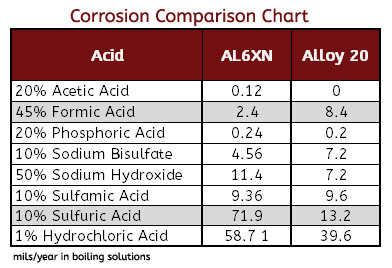These two alloys are often confused as being almost the same, which is almost true. They are both nickel alloys and share many key characteristics. AL6XN and Alloy 20 are alike in that they each retain their strength to about 1000°F. In addition they both perform well, in salt water environments, providing excellent resistance to crevice and pitting corrosion as well as stress corrosion cracking. This is where their similarities actually end. In this brief newsletter, we’ll highlight key differences between AL6XN and Alloy 20, so you’ll know when to select one alloy over the other.

First let’s start with what these alloys are made of. They are both primarily made of Nickel, Chromium, Molybdenum and Iron, along with trace amounts of other elements. A key difference is that AL6XN contains a higher molybdenum and iron content making it stronger than Alloy 20. In contrast, Alloy 20 is the winner in terms of nickel content, which improves its corrosion resistance.

Acid Corrosion Resistance
Alloy 20 was designed specifically to withstand the harsh environment of hot sulfuric acid. In these conditions, Alloy 20 fasteners far out performs AL6XN. These fasteners offer good resistance to stress-corrosion cracking in boiling sulfuric acid at specific range of 20% to 40% concentration, as well as general sulfuric acid resistance. Though Alloy 20 has better overall corrosion resistance in most acids, AL6XN is a better choice when it comes to formic acid.
Strength
Due to the fact that AL6XN fasteners contains a higher content of iron and molybdenum, it has a yield strength that is approximately 50% higher than that of Alloy 20 fasteners.
Which Is Better?
Put simply, it depends on your application. Alloy 20 leads in general acid protection, whereas AL6XN has an edge in strength and some specific solutions. Both are interchangeable for use in salt water and both perform well at temperatures up to 1000°F.
Corrosion: Alloy 20
Strength: AL6XN
Salt water: Equal
Temperature: Equal
